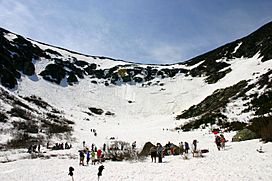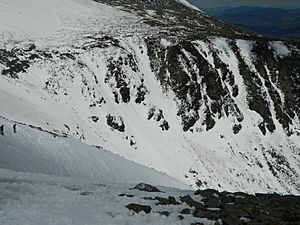Tuckerman Ravine facts for kids
Quick facts for kids Tuckerman Ravine |
|
|---|---|

Tuckerman Ravine with late spring skiers after the headwall has thawed
|
|
| Floor elevation | 4,430 ft (1,350 m) |
| Geography | |
| Location | New Hampshire, United States |
| Mountain range | White Mountains |
Tuckerman Ravine is a special bowl-shaped valley on the side of Mount Washington in New Hampshire. It's part of the White Mountains. People love to visit it all year round for hiking. But it's most famous for "spring skiing." From April to July, many skiers hike up and then ski down its steep slopes.
Even when it's warm, Tuckerman Ravine has lots of snow. This is because Mount Washington's strong winds blow huge amounts of snow into the ravine. The snow can be as deep as 55 feet in winter! Thousands of people come to ski here on a single spring weekend. Skiing is also possible in winter, but it's much more dangerous. Avalanches can happen, so special training is needed to stay safe.
People often call the ravine "Tucks" for short. You can easily get there from the AMC Visitor Center. This center is on New Hampshire Route 16 at Pinkham Notch. From there, it's about a 2.4-mile hike on the Tuckerman Ravine Trail. This trail is also used by snowmobiles in winter and spring.
Exploring Tuckerman Ravine
Tuckerman Ravine is like a giant natural ski park. It has many different paths, or "runs," that go down the bowl. These runs are very steep, from 40 to 55 degrees!
If you look from the bottom, the path on the far left is called "Left Gully." It's one of the easier ways down. As you move to the right, the runs get harder and steeper. "The Chute" is a path that goes between two big cliffs.
Even further right are the "Center Gullies." One part, "The Icefall," is super steep at 55 degrees. Skiers here often jump off cliffs that are 25 feet tall! Next to "The Icefall" is "The Lip." This is an open run that's also very steep, around 50 to 55 degrees. "Right Gully" is another easier run. It drops into a section called "The Sluice" and is about 40 degrees steep.
History of Tuckerman Ravine
The ravine is named after Edward Tuckerman. He was a botanist who studied plants and lichens there in the 1830s and 1840s.
The first person known to ski on Mount Washington was Dr. Wiskott from Germany in 1899. The first person to ski in Tuckerman Ravine itself was John S. Apperson in April 1914.
Sadly, there have been some accidents over the years. The first known death in the bowl was in 1886 from falling ice. The first death from skiing happened in April 1943.
In 1933, a group called the Civilian Conservation Corps started building ski trails. They built the John Sherburne Ski Trail on Mount Washington. This trail goes from the Hermit Lake cabin down to the Pinkham Notch Visitors Center.
The steepest part of the ravine, called the "headwall," was first skied by two students from Dartmouth College. Their names were John Carleton and Charles Proctor. They skied it on April 11, 1931. Soon after, students from Harvard University skied the headwall all the way from the summit of Mount Washington. Tuckerman Ravine quickly became a very important place for extreme skiing in New England.
American Inferno Races
In the 1930s, exciting ski races were held in Tuckerman Ravine. These races brought huge crowds of people. There were slaloms, Olympic tryouts, and giant slaloms. But the most famous races were the three "American Infernos."
These races were named after a similar race in Switzerland. The idea was a 4.2-mile race from the summit of Mount Washington to the base. The first American Inferno was on April 16, 1933. Hollis Phillips won it in 14 minutes and 41 seconds. The next year, Dick Durrance won and beat the record with a time of 12 minutes and 35 seconds.
The 1939 American Inferno is still talked about today. A skier named Toni Matt, who was from Austria, made a famous decision. He decided to ski straight down the headwall without turning! Matt had won many downhill races before. He later remembered thinking, "I went right and then left and then right and then said, well, now is the time to straighten them out." He went straight down, reaching a top speed of 85 miles per hour! Matt finished his run in an amazing 6 minutes and 29.4 seconds.
Toni Matt stopped racing in 1951 because of a leg injury. But he continued to coach and help with ski events around the world. In 1967, he was added to the Ski Hall of Fame.


